
John Harrison was an English carpenter and clockmaker who invented the marine chronometer, a long-sought-after device for solving the problem of how to calculate longitude while at sea.

The Worshipful Company of Clockmakers was established under a Royal Charter granted by King Charles I in 1631. It ranks sixty-first among the livery companies of the City of London, and comes under the jurisdiction of the Privy Council. The company established a library and its museum in 1813, which is the oldest specific collection of clocks and watches worldwide. This is administered by the company's affiliated charity, the Clockmakers' Charity, and is presently housed on the second floor of London's Science Museum. The modern aims of the company and its museum are charitable and educational, in particular to promote and preserve clockmaking and watchmaking, which as of 2019 were added to the HCA Red List of Endangered Crafts.

A clockmaker is an artisan who makes and/or repairs clocks. Since almost all clocks are now factory-made, most modern clockmakers only repair clocks. Modern clockmakers may be employed by jewellers, antique shops, and places devoted strictly to repairing clocks and watches. Clockmakers must be able to read blueprints and instructions for numerous types of clocks and time pieces that vary from antique clocks to modern time pieces in order to fix and make clocks or watches. The trade requires fine motor coordination as clockmakers must frequently work on devices with small gears and fine machinery.

John Arnold was an English watchmaker and inventor.

The Clockmakers' Museum in London, England, is believed to be the oldest collection specifically of clocks and watches in the world. The collection belongs to and is administered by the Clockmakers’ Charity, affiliated to the Worshipful Company of Clockmakers, founded in 1631 by Royal Charter. Since 2015 it has been housed in a gallery provided by the Science Museum in South Kensington, having formerly been located in the Guildhall complex in the City of London since 1874, where it first opened to the public. Admission is free.
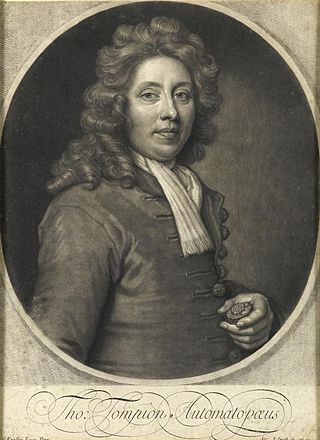
Thomas Tompion, FRS (1639–1713) was an English clockmaker, watchmaker and mechanician who is still regarded to this day as the "Father of English Clockmaking". Tompion's work includes some of the most historic and important clocks and watches in the world, and can command very high prices whenever outstanding examples appear at auction. A plaque commemorates the house he shared on Fleet Street in London with his equally famous pupil and successor George Graham.
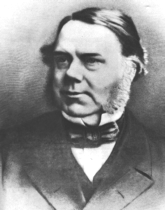
Charles Frodsham was a distinguished English horologist, establishing the firm of Charles Frodsham & Co, which remains in existence as the longest continuously trading firm of chronometer manufacturers in the world. In January 2018, the firm launched a new chronometer wristwatch, after sixteen years in development. It is the first watch to use the George Daniels double-impulse escapement.

A Japanese clock is a mechanical clock that has been made to tell traditional Japanese time, a system in which daytime and nighttime are always divided into six periods whose lengths consequently change with the season. Mechanical clocks were introduced into Japan by Jesuit missionaries or Dutch merchants. These clocks were of the lantern clock design, typically made of brass or iron, and used the relatively primitive verge and foliot escapement. Tokugawa Ieyasu owned a lantern clock of European manufacture.
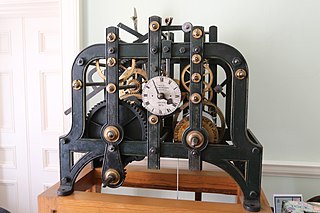
The British Horological Institute (BHI) is the representative body of the horological industry in the United Kingdom. It was founded by a group of clockmakers in 1858, and has its current premises at Upton Hall in Nottinghamshire, which includes a museum of clock history.
Edward Martin Burgess FSA FBHI, known as Martin Burgess, was an English horologist and master clockmaker.
Jonathan Betts MBE is Curator Emeritus at the Royal Observatory in Greenwich, England, a horological scholar and author, and an expert on the first marine timekeeper which was created by John Harrison in the middle of the 18th century. Betts was formerly Senior Specialist in horology at Greenwich. Between 2016 and 2019 he served on the board of trustees of the Institute of Conservation.
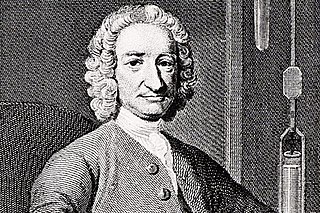
Daniel Quare was an English clockmaker and instrument maker who invented a repeating watch movement in 1680 and a portable barometer in 1695.

The American Clock & Watch Museum (ACWM), located in Bristol, Connecticut, is one of a very few museums in the United States dedicated solely to horology, which is the history, science and art of timekeeping and timekeepers. Located in the heart of the historic center of American clockmaking, ACWM is the world's preeminent horological museum in the area of American clocks, primarily industrial-made clocks of the 19th and early 20th century.

Benjamin Lewis Vulliamy was a clockmaker, active in 18th and 19th century Britain. He succeeded his father Benjamin Vulliamy as head of the firm and Clockmaker to the Crown.

Joseph Knibb (1640–1711) was an English clockmaker of the Restoration era. According to author Herbert Cescinsky, a leading authority on English clocks, Knibb, "next to Tompion, must be regarded as the greatest horologist of his time."
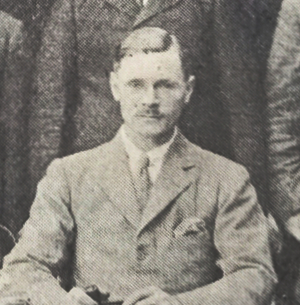
Cyril Frederick Cherrington Beeson CIE, D.Sc. (1889–1975) was an English entomologist and forest conservator who worked in India. Beeson was an expert on forest entomology who wrote numerous papers on insects, and whose book on Indian forest insects remains a standard work on the subject. After his retirement and return to England he became an antiquarian horologist.
John Knibb (1650–1722) was an English clockmaker born in Claydon, Oxfordshire. He produced various clocks and watches including bracket clocks, lantern clocks, longcase clocks, and some wall-clocks, as well as building and maintaining several turret clocks. Even though his main market was catering to customers of modest means, he also dominated the higher-quality sector. Only six of Knibb's watches are known to survive.

Eric John Dingwall (1890–1986) was a British anthropologist, psychical researcher and librarian.

Donald Jay Saff is an artist, art historian, educator, and lecturer, specializing in the fields of contemporary art in addition to American and English horology.
Charles Gretton was an English clock and watchmaker during the golden age of English clockmaking.
















